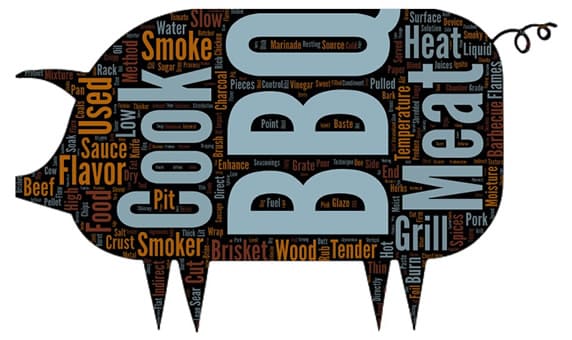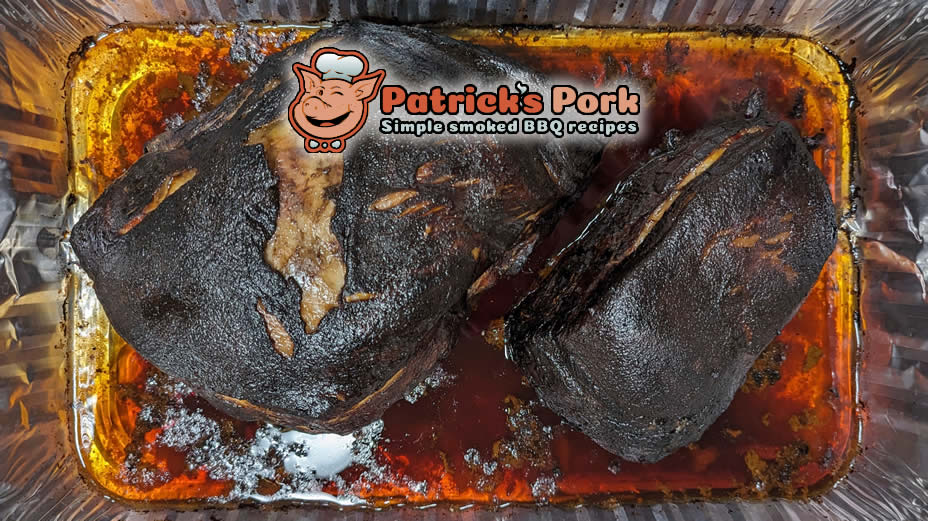BBQ Terminology
BBQ cooking has some unique terms and words.
Speaking the language of BBQ

Here is a list of 50 common terms used in BBQ cooking.
- Barbecue (BBQ): A method of cooking meat, typically
slow-cooking over low, indirect heat with wood smoke to impart a
smoky flavor.
- Barbecue Pit: A dedicated cooking area or structure
designed for barbecue, often equipped with grates, racks, or hooks
for smoking or grilling meat.
- Bark: The flavorful, caramelized crust that
forms on the surface of smoked meat, often achieved by slow cooking
at low temperatures.
- Baste: To brush or pour liquid (such as a sauce
or marinade) over food while it cooks to keep it moist and add flavor.
- BBQ Pit Sauce: A thick, sweet, tangy sauce
used for basting or brushing onto meat during cooking or served
as a condiment.
- BBQ Sauce: A sauce made from a combination
of ingredients, such as tomato paste, vinegar, sugar, spices, and
seasonings, used for glazing, dipping, or serving with grilled or
smoked meat.
- Brine: A solution of salt, water, and sometimes
sugar and spices used to soak meat before cooking to enhance its
flavor, moisture, and tenderness.
- Brisket Flat: The leaner, flatter part of the
beef brisket known for its firm texture and rich beef flavor
- Brisket Knife: A long, thin-bladed knife designed
explicitly for slicing brisket, allowing for clean, even cuts.
- Brisket Point: The beef brisket's thicker,
more fatty end is known for its juiciness and tenderness when properly
cooked.
- Brisket: A cut of beef from the chest area
of a cow, usually slow-cooked until tender and commonly associated
with Texas-style barbecue.
- Burn-off: The process of heating a grill or
smoker to a high temperature to burn off any residual food or grease
from previous cooking sessions.
- Burnt Ends: A popular dish made from the crispy,
flavorful pieces of meat cut from the point end of a smoked brisket.
- Butcher Paper: A sturdy, food-grade paper used
for wrapping meat during cooking to retain moisture and protect
it from direct heat.
- Charcoal: A black substance obtained by heating
wood in the absence of oxygen, used as a fuel source for grilling
and smoking.
- Chimney Starter: A metal cylinder used to ignite
charcoal quickly and evenly, creating hot coals for grilling or
smoking.
- Cold Smoking: A smoking method where the food
is exposed to smoke without direct heat, typically at temperatures
below 90°F (32°C).
- Direct Heat: Cooking food directly over the
heat source, such as placing it directly above the flames.
- Dry Rub: A blend of dry spices and seasonings
applied to meat before cooking, without any added liquid.
- Flare-up: Sudden bursts of flames caused by
fat or juices dripping onto hot coals or flames, requiring attention
to prevent burning the food.
- Flipping: Turning food over during cooking
to ensure even heat distribution and prevent one side from burning.
- Foil Wrap: Enclosing meat in aluminum foil
during cooking to retain moisture and enhance tenderness.
- Glaze: A sauce or liquid mixture applied to
meat during cooking to give it a glossy appearance and add flavor.
- Grilling: Cooking food directly over high heat,
usually on a grill grate.
- Hot Smoking: A smoking method where the food
is exposed to smoke and cooked simultaneously at temperatures ranging
from 180°F to 275°F (82°C to 135°C).
- Indirect Heat: Cooking food away from the heat
source, usually by placing it to the side of the flames or using
a heat deflector, allowing for slower, more controlled cooking.
- Injector: A device used to inject marinades
or other liquids into meat to enhance flavor and moisture.
- Marinade: A liquid mixture of oil, vinegar,
herbs, spices, and other flavorings used to tenderize and flavor
meat before cooking.
- Minion Method: A technique for maintaining
low and steady temperatures in a charcoal smoker by strategically
arranging unlit charcoal and adding a small amount of lit charcoal
on top.
- Mop Sauce: A thin, often vinegar-based sauce
applied to meat during cooking to add moisture and flavor.
- Offset Smoker: A
type of smoker where the
firebox is located beside the cooking chamber, allowing smoke and
heat to flow indirectly over the food.
- Pellet Grill: A type of grill or smoker that
uses wood pellets as fuel, providing a convenient way to control
temperature and add smoke flavor.
- Pit Barrel Cooker: A specific type of smoker
that uses a vertical drum design to cook meat, known for its simplicity
and versatility.
- Pit: A structure or device used for cooking
meat over an open fire or with indirect heat, often associated with
traditional barbecue cooking.
- Pitmaster: A skilled cook
who uses wood smoke to barbecue, often specializing in specific
techniques and flavors.
- Pulled Chicken: Cooked chicken that is shredded
or pulled into thin strips.
- Pulled Pork:
Slow-cooked pork shoulder or butt that is shredded or "pulled" into
small pieces.
- Resting Rack: A raised rack or grate used to
elevate cooked meat off the surface to allow air to circulate and
prevent condensation from making it soggy.
- Resting: Allowing cooked meat to sit undisturbed
for a period of time after cooking to allow the juices to redistribute
and ensure tenderness.
- Reverse Sear: A cooking method where meat is
first slow-cooked at a low temperature and then finished with a
high-temperature sear to achieve a flavorful crust.
- Ribs:
Cuts of meat, typically pork or beef, from the ribcage that are
cooked slowly until the meat is tender and flavorful.
- Rub: A mixture of herbs, spices, and other
flavorings applied to meat before cooking to enhance its flavor
and form a crust.
- Sear: Browning the surface of meat quickly
over high heat to develop a flavorful crust.
- Smoke Chamber: The enclosed section of a smoker
or grill where the food is placed for smoking.
- Smoke Ring: A pink discoloration near the surface
of smoked meat, caused by a chemical reaction between the smoke
and the meat's myoglobin.
- Smoked Sausage: Sausages made from ground meat,
such as pork or beef, that are flavored with spices and smoked over
low heat.
- Smoking: A cooking method where food is cooked
slowly over low heat, often using hardwood chips or chunks to produce
smoke.
- Thermometer: A tool used to measure the internal
temperature of meat to ensure it is cooked to the desired level
of doneness.
- Water Pan: A pan filled with water placed in
a smoker or grill to help regulate temperature, provide moisture,
and prevent excessive drying of the meat.
- Wood Chips:
Small pieces of wood, often soaked in water, used in smokers or
grills to produce smoke and infuse food with a smoky flavor.

Did you
know?
Smoke preservation back in the day. Smokehouses allowed early Americans to preserve meat for longer
periods, especially in the absence of modern refrigeration
methods. Smoking not only imparted flavor but also helped to dry
out the meat and discourage the growth of bacteria and spoilage.
Pork Cooking Resources

